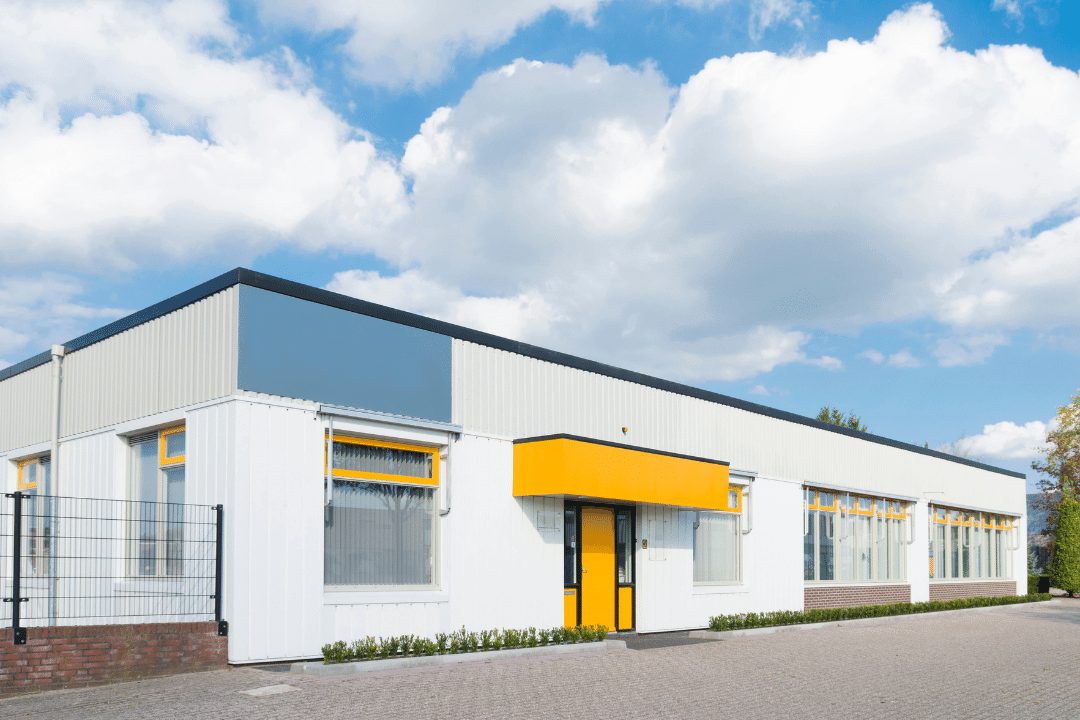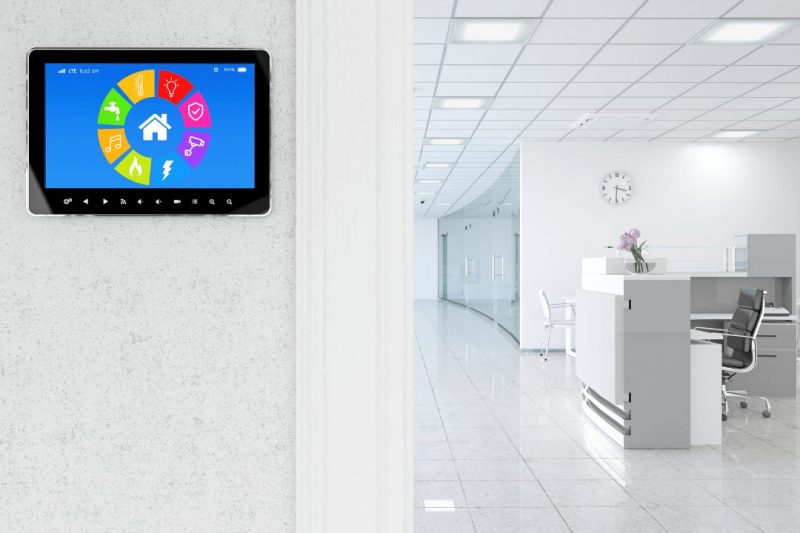Building automation solutions are excellent additions to large commercial properties, but how can they benefit small buildings?
When you think about building automation systems, what comes to mind? Probably large-scale developments like office buildings or hotels require sophisticated technology to monitor large open areas. While that is true in many cases, there are lots of applications that are useful for smaller buildings.
A major concern that we’ll be covering is cost. It is often thought that automation requires expensive technology and invasive renovations to introduce automation into a building.
However, for most small buildings, extensive renovations are not within the budget. That’s why today we’re going to be looking at some building automation solutions that can be easily installed and improve how your building functions.
Not to mention, we’ll be discussing how these low-cost solutions will save your business money in the long term. We’re going over everything from lighting control systems to security and HVAC solutions that will help you optimize your small building operations.
Ready to take a look at a few ways you can use automation to improve your operations and save money? Let’s get started!
Table of Contents
What is a Building Automation System (BAS)?
Building automation systems can control and adjust your operating systems for optimized output
Building automation systems allow large buildings to function properly.
Before we can start talking about how building automation solutions are perfect for small buildings/small businesses, we should first explore how they work.
A building automation system is a network connected via the Internet of Things (IoT) that can operate, adjust, manage, and improve upon your existing building systems. That means that your building automation system can all control your lighting, HVAC, plumbing, and more.
These systems act as the “brain” for large commercial buildings and can provide high-level insights to building managers. These insights are important for building operations and help building managers save energy and money. However, installing a BAS system in a small building is prohibitively expensive, which is why other building automation solutions are so important.
Why Are Building Automation Solutions Beneficial for Small Buildings?
Small buildings have a huge opportunity to conserve energy and save money with building automation solutions
Smaller buildings can still benefit from non-BAS solutions.
As it currently stands, small buildings are an untapped market for building automation solutions. As we previously mentioned BAS systems and other solutions are most often associated with large buildings that require complex applications to run properly.
That leaves a big gap in the market when it comes to smaller or even medium-sized buildings. And, since there are more small buildings than there are large buildings, there are a huge number of businesses that could benefit from automation that don’t realize it is a viable solution.
What are the Major Reasons Small Buildings Don’t Install Building Automation Solutions?
Let’s explore why so many small building owners are missing out on the benefits of automatic operations
Automation saves money and improves the lives of all inhabitants.
The main reason why small buildings do not take advantage of automation is due to cost. While installing a whole BAS can be expensive, there are ways to make sure that you aren’t breaking the bank while optimizing your space.
For a fully functional BAS system including plumbing, HVAC, lighting, and more, most businesses are looking at anywhere from $2.50 to $7 per square foot.
Depending on the size of your building, this may sound like a steep price—and for some it is. That’s why we’re going to be discussing ways you can integrate smart technology into your building without a scary price tag attached.
Low-Cost Building Automation Solutions for Small Buildings
Now that we’ve established why many small buildings aren’t interested in BAS systems, let’s look at some easy ways to optimize a small building
Make operations easier by building managers with these automated solutions.
Though a full-fledged BAS system would be nice to install for a smaller building, for lots of places it just isn’t an option. So, to help you optimize your smaller building, we’re taking an in-depth look at the best building automation that doesn’t require professional installation and is available to businesses at a low cost. Let’s get started!
Automated Lighting Applications
If your building is too small to warrant a full BAS system, there are still a lot of options out there that you can use to cut costs and make life easier for everyone who enters. First up, are daylight sensors. Daylight sensors are excellent ways that you can get some of the benefits of a BAS system without the expense or need for system updates.
By installing light sensors in your building, your lights will be able to adjust based on the amount of ambient light that enters the building. This maximizes energy efficiency as you won’t be wasting power-lighting space in a building that has sufficient natural light already.
A second option that you can use for a smaller building is an energy monitoring sensor. These handy tools will tell you how much energy your building uses daily and let you know how long each light was turned on that day.
By regularly consulting your energy monitor, you can determine areas for improvement when it comes to lighting energy conservation.
Another way that you can improve your small building lighting automation without professional installation is with low-cost occupancy sensors. Occupancy sensors do not require that your building is equipped with a BAS and can drastically reduce the amount of energy your business consumes.
Everyone knows someone who habitually leaves the lights on after they’ve left the room—and while this may seem like a small annoyance, it will eventually add up to big energy costs. When you install occupancy sensors in your building, you won’t have to continuously worry about lighting unoccupied spaces.
Speaking of lighting unoccupied spaces, one of the easiest and least expensive things to do for your small building is to install smart light bulbs.
Smart light bulbs usually cost no more than $20 and are packed with useful features that more than make up for the price. By replacing older incandescent or fluorescent light bulbs with smart LED bulbs, you’ll cut down on energy usage and reap the benefits of remotely controlled lighting.
Even if the lights are accidentally left on by a building occupant, you can check the status and turn off the lights wherever you are—as long as there’s WiFi. Smart bulbs are also great options for spaces that require frequent lighting changes, like event spaces for example.
Using an application on your phone, you’ll be able to adjust lighting by brightness, hue, and color. These also work well with occupancy or ambient lighting sensors as these can be paired with smart light bulbs via WiFi connection.
Automated Security Applications
Security is a major concern for any building owner, but for smaller buildings, security measures are sometimes not as comprehensive as they need to be.
That’s why so many small buildings are looking for added security measures that do not require a full-fledged BAS to manage properly. Recently, there have been more low-cost automated security measures that small building owners can install that will keep the building and all inhabitants safe.
Right now, you can improve your security system using low-cost sensors connected to WiFi. There are a lot of different types of sensors that you can use for increased building security.
For example, you can install motion sensors around your building that will automatically turn on your outdoor lights—deterring potential intruders. These sensors can also be programmed to automatically turn on outdoor security cameras.
Installing sensors inside of the building is another way that smaller buildings can increase security with the help of automated solutions. Just like the outdoor sensors, these sensors can trigger security cameras and lights to ward off potential intruders.
While we may think of security as simply preventing break-ins and other types of crime, there are a few other elements of safety that we should discuss.
For example, you can install fire and flood sensors in your building to prevent potential disasters. These sensors can be life-saving when it comes to unpredictable emergencies. Not to mention, you may be able to take advantage of insurance breaks by installing these added automated safety measures to the building.
Automated HVAC Applications
Every building—no matter how large or small—requires temperature regulation. However, for a lot of building owners, the cost of heating and cooling is overwhelming—sometimes up to 50% of a monthly utility bill.
Luckily, there are several affordable building automation solutions that building owners can use to cut costs and provide a more comfortable environment for anyone who enters.
One of the easiest and most cost-effective ways to take advantage of automation in a small building is by installing a smart thermostat. Smart thermostats have a wide range of capabilities even though they are relatively inexpensive and easy to install.
Using a smart thermostat, you can pre-scheduled heating and cooling for different times of the day. If you own an office building where employees work from 9 AM to 5 PM, you can program your HVAC system to turn on only when the building is occupied.
Smart thermostats also can recognize opportunities for energy savings or have energy-saving modes that automatically adjust the output to save energy without compromising comfort.
Some of the higher-end smart thermostats even offer zoned heating and cooling. Zoned heating and cooling is when individual rooms or parts of your building are temperatures controlled separately from the rest of your building.
Zoned heating allows building occupants to pre-set temperatures and designate in-use rooms that should be climate controlled during working hours, meetings, or any other use.
We should also mention that not every room in a building is used for the same purpose. For example, some rooms house materials that require close temperature control.
With a smart thermostat and zoned heating and cooling, you can ensure that specific rooms stay at an ideal temperature at all times, while other rooms in the building can be adjusted.
Overall, a smart thermostat brings a lot of the building automation solutions usually associated with complete BAS systems to small buildings at a much more reasonable price. A smart thermostat will not only make a small building more comfortable, but its features can significantly cut down on monthly energy consumption.
Before we move on, there is one more important aspect of automated HVAC solutions we need to discuss—ventilation. Since the initial outbreak of COVID-19, there has been a greater focus on indoor air quality. As people are returning to work in person, good air quality is among one of the top concerns.
To adapt to the changing working world, many buildings have installed ventilation systems that filter dirt, debris, and other indoor pollutants. These ventilation systems have been proven to reduce the spread of COVID-19 and are important for providing overall healthier air to all inhabitants.
Ventilation systems do not require a BAS, but they can be programmed automatically. Using the built-in controls for your ventilation system, you can schedule times for fresh air to be pumped into the building. You can also integrate occupancy sensors into your ventilation system.
These sensors will trigger the ventilation system to start a filtration cycle when the occupancy of your building reaches a designated threshold.
By installing a ventilation system in your building, you are not only taking advantage of the available building automation solutions, but you are also making the building as safe and healthy as possible.
How Can I Make Sure I Am Getting the Best Possible Building Automation Solutions?
If you want to take advantage of these automation solutions, there are a few considerations to take into account first
Cybersecurity is a big point of concern for all automated solutions.
Now that we know about a few of the different building automation solutions that you can use for a small building without the need for a BAS, it is important to discuss how you can choose the best products. Since the technology we’ve been discussing is no longer as expensive or prohibitively complex as it used to be, so many products have hit the market just in the last few years.
Because there are so many, it can be difficult to know that you’ve chosen the right one for your building that fits your budget. Let’s take a look at a few important things you need to consider before investing in one of the automated solutions we’ve discussed.
Cybersecurity
We’ve mentioned throughout that these devices do not need a central BAS system to function properly—all you need is a WiFi connection. However, when devices are as critical as security cameras or automated smoke detectors, you need to make sure that your wireless network is secure.
Without added wireless security, your WiFi network is open to others and is vulnerable to hackers. Should your wireless network become compromised, there are a lot of important functions that will go down as well.
To prevent a cyberattack from bringing your building operations to a standstill, you should take some digital precautions. One of the easiest ways to protect your network is by setting up two-factor authentication on all devices. By taking the extra step to verify all logins, you can protect your new automated solutions from attacks.
Interoperability
Since a BAS system is not an option for many smaller buildings due to cost, it is important that your automation solutions work together. When you are searching for different solutions, you want to make sure that they are compatible.
Not every automated device needs to be compatible but some need to work together. For example, you need to make sure that your occupancy sensors are compatible with your ventilation system. If the systems are not compatible, then your sensors are virtually useless.
It is important to do your research and find products that will work with either your existing systems or ones you plan to install in the future.
Reliability
The last thing you want to consider when selecting different automated products is reliability. Since most of these building automation solutions are in use every day, you need to do the research and make sure that each device will function properly over a long period. Just in case, you should double-check to see if the devices have a warranty.
From there, you can explore online reviews to find out the durability and functionality of the devices over time.
Once you’ve done your research and made a few decisions regarding the automation solutions you want for your small building, you’re ready to go!
There are more ways to take advantage of automation than ever before—and the options are out there waiting for you! Start saving money, and energy, and optimizing your small building today with the help of automation.











